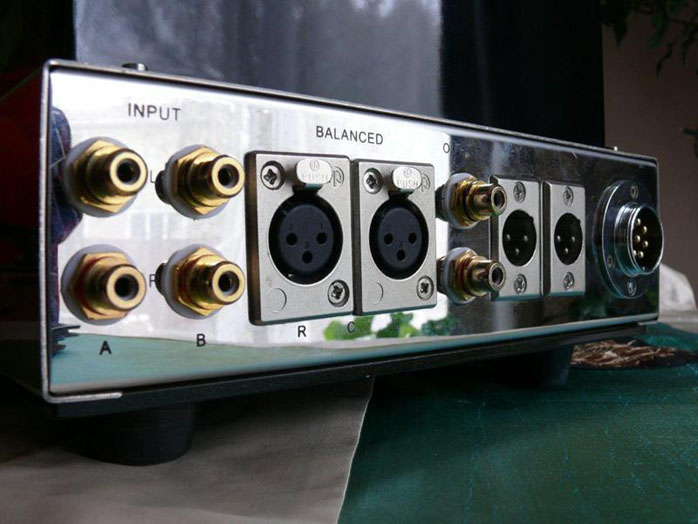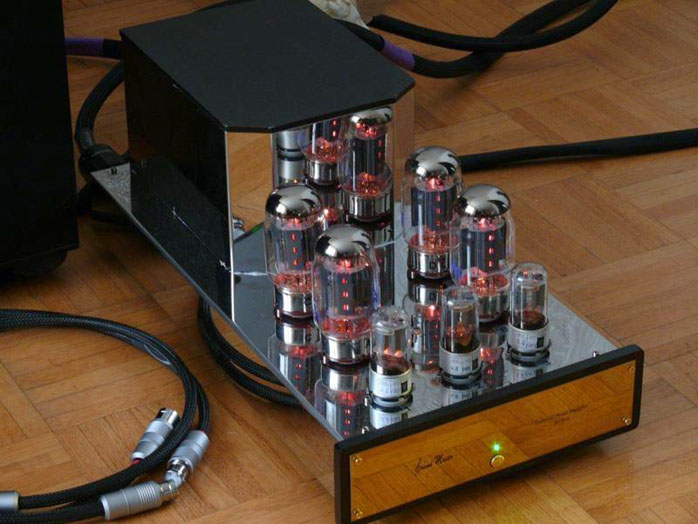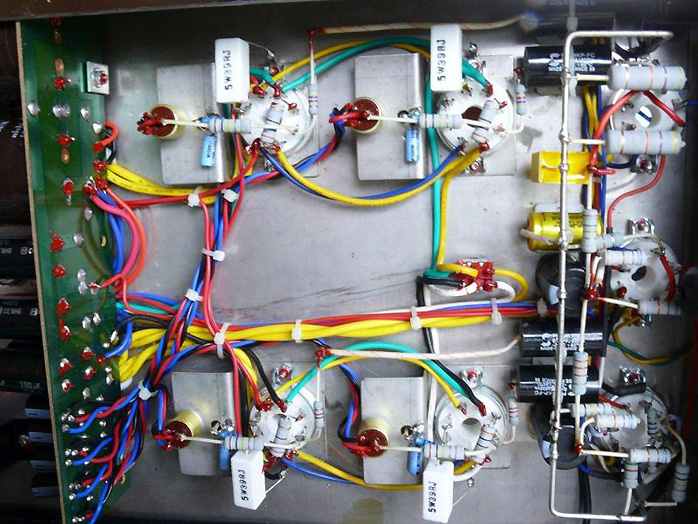This review page is supported in part by the sponsors whose ad banners are displayed below |
 |
 |
|
 |
"Emma Woodhouse was born" from the CD Music From the BBC Television series Emma: Samuel Sim [Moviescore Media MMS09028] is one cut of a delightful album in classical style making excellent use of the Chamber Orchestra of London. Close miking reveals the album’s soundtrack origins as the recording emphasizes orchestral texture over a purist documentation of a live event. Fine detailing and interplay highlight haunting music by a talented composer that leaves one wanting for longer pieces than the collection of sound bites here.
"Like a Virgin" from the Big Daddy Cutting Their Own Groove [Rhino R2 70733] - Big Daddy is a talented group of musicians who specialize in taking current hits and presenting them in the style in which they would have been performed by groups from the 50s. This CD goes beyond novelty status based on the fact that the performers have real command of the material and the recording is quite good. There is an almost analog dimensionality here with a huge soundstage and delicate detail. An audiophile salute with tongue in cheek paired with a delivery which occasionally supersedes the original material.
"Corcovado" from We Get requests: The Oscar Peterson Trio [FIM LIM K2HD 032] is
classic light jazz by the legendary Oscar Peterson Trio recorded in 1964 and given fresh life by producer Winston Ma in a 24bit 100kHz remastered CD. Delicate tickling of the ivories, deep bass and shimmering cymbals captured in an emotionally involving performance put one at ease and bring a contented smile.
"Shenandoah" from FIM Super Sounds II [FIM XR24 067] is another fine Winston Ma remaster, this time a binaural recording fusing sounds of nature with a small group of musicians awash in ambient information. A tranquil fusing of outdoor transparency and warm artificial acoustic envelope, with acoustic guitar taking the spot light.
"Nativity Carol" from Star of Wonder [Reference RecordingsRR-21CD] is a legendary recording by Reference Recording’s Keith O. Johnson of the San Francisco Choral Artists performing in the Saint Ignatius Church in San Francisco. Huge hall acoustic with richly detailed choral work punctuated by a massive organ. Sweet, delicate and teeth rattling.
"You’re Just a Country Boy" from A Hundred Miles or More: A Collection by Alison Krauss [Rounder 1166105552] is a little Country outing. Alison Krauss has a gentle wisp of a voice that constantly threatens to vanish but gains power through intricacy and subtlety. A casual relaxed presentation with effective backup orchestration which punctuates rather than overpowers.
"You‘re Driving me Crazy" from From the Age of Swing: Dick Hyman [Reference Recordings RR-59CD] is a jazz number that captures the soundstage, frequency range, subtle detail and wide swelling dynamics of a fine performance - perfect for exploring the dynamic capabilities and compression in a system while being thoroughly entertained.
"Somebody to Love" sports Leighton Meester featuring Robin Thicke from the CD Valentine’s Day Original Motion Picture Soundtrack [Big Machine Records ORBM 7326] in sometimes a little more current vein with basic bouncy pop music. The piece has surprisingly good focus with a driving beat. It’s a fun little compilation CD of varying technical merit.
The basic noise floor on both units was low to allow for good low-level detail. Clipping characteristics were gentle, favoring compression rather than grossly audible distortion and this allowed for a further enhancement of low-level information when the tubes were pushed hard. Neither the preamplifier nor amplifiers showed evidence of high-frequency grain. The preamplifier was quite sweet and extended. The amplifiers showed a combination of neutrality and good hard edge in UL mode and exceptional sweetness in triode. |
|
|
 |
The preamplifier had a minor problem in the left channel with low-level hum which couldn‘t be cured by cable or grounding changes. The anomaly was confined solely to that side, the right channel being dead quiet. The hum was low enough to not interfere with the listening evaluations and since the unit had experienced a bit of shipping damage, I chalked it up to that. During initial break in there was a small amount of tube noise on turn on but this disappeared to inky black silence as time went on. The reputation for microphonics with the PX4 was anticipated but never materialized. The amplifiers were flawless and dead quiet. The muting relay never allowed any undesired sound to be produced until the amplifiers were ready to go.
|
 |
Let’s begin with the No.23 Mk II preamplifier. The output of the Sound Master line stage was lower than any preamplifier that has run in my system before and my descriptions regarding its dynamic behavior must be taken as a worst case scenario. The No.23 Mk II achieved maximum dynamics from the midrange on up. Even here driven to levels approaching normal the preamplifier gracefully began to distort, first by increasing levels of compression, then a progressive collapse of soundstage depth. Bass was problematic and ultimately the weakest area of reproduction. The unit achieved decent detail and dynamics into the mid bass but below there was diminution of dynamics and control until at the very bottom of the range, the preamplifier exhibited obvious audible distress. This was most apparent running full balanced due to the drop in gain in this mode. Dynamics were shown to better advantage in single-ended configuration, gaining both greater weight and proportional level. Overall articulation and attack were good, the unit being light on its feet and never sounding ill-defined or sluggish.
|
 |
The preamplifier showed evidence of decent dynamics at lower listening levels and the potential for wider capability. Given headroom to breath with higher efficiency speakers, the preamplifier should do a considerably better job of delivering nuance and good dynamic range. In the context of my system however, both the Audio Space Reference 2S and the Acoustic Buoy Scorpio preamps offered considerably wider capabilities. Confronted with the requirements of the Apogees—the manufacturer was fully appraised of my system before choosing to dispatch these particular components—- the preamplifier was intriguing but ultimately restrained.
|
|
|
The Sound Master No.88.6 Reference amplifiers were not encumbered by any of the limitations of the preamp. The monos made good use of the venerable KT88 workhorse. They were robust and capable of delivering very good real dynamics and gave the illusion of producing even wider dynamics than their power ratings would indicate. The gentle clipping of the KT88 compressed the range slightly but the result was to bring up low-level material and coupled with a low noise floor, contributed to the appearance of enhanced resolution and power. Only direct comparison to the higher-power Bel Canto revealed the deficiency and showed how artfully the illusion was accomplished.
|
 |
In evaluating the performance of the No.88.6 Reference in UL versus triode, the differences were immediately obvious. The Sound Master became two completely different amplifiers with unique characteristics. In triode, the amplifier concentrated on dynamic nuance especially in the midband but at the expense of power and response in the lower octaves. This was most noticeable with the Sound Master preamp and especially in full-balanced configuration where it spotlighted the preamplifier’s weakness in that range. In single-ended mode this pairing gained some much needed dynamic legs and was quite engaging.
|
 |
In UL, the amplifier proved a capable trooper with the Apogees and flexed some much needed authority. When paired with the Audio Space Reference 2S, the amplifier gained a more extensive dynamic range and considerable extension into the lower octaves. Low bass pedal point had power and good control and proved the amplifiers had no problem delivering current into the speaker load. The TrueHarmonix Black Magic CD Mat was beneficial in extracting greater resolution and dynamic detail from every CD playback device it was used with, revealing better gradation into the lower limits of the dynamic floor. Leading edge information and especially trailing edge were better defined, giving longer decay on instruments and better differentiation of the acoustical space around them. It also removed a layer of false air on some recordings, making the acoustical information sound less processed and more real.
|
|
|
The No.23 Mk II preamplifier always drew attention to its handling of the midrange. The PX4/n tube lives, breathes and inhabits this range with a vengeance and performance here rivaled the best capabilities of my own Audio Space Reference 2S. It was eminently refined, detailed and seductive. As with the 300B, there was a combination of detail and delicacy that extended up the range with remarkable sweetness. In the higher frequencies, the preamplifier managed to sound both extended and sweet at the same time without a serious penalty in detail or transient snap, doing slightly better in this regard than my Reference 2S. The overall character was closely kindred to my 300B-based preamplifier and contributed a more romantic viewpoint than the ultimately more accurate presentation of the Scorpio or the linestage section of the Wyred4Sound STI 1000. If the Sound Master No 23 Mk II failed on this absolute level of neutrality, it did succeed on the level of being exceptionally convincing and in some ways being more truthful to the original event rather than recording.
|
 |
Where the midrange spotlighted the preamplifier’s virtues, the bass was problematic, falling off in response and dynamics in the context of my setup. The response was satisfying on weight, warmth and articulation to the limits of acoustic instruments like the cello or piano but diminished further down. As a result, organ music and subwoofer material were less well served. A curious side effect of this diminution in the extreme lower registers was an apparently better articulation further up. The character was always light and lively even into the lowest bass limits it could accomplish and never got blunted, ill-defined or sluggish.
|
 |
This bass situation improved somewhat at lower playback levels and improved further when switching from balanced to single-ended. Output became more linear in response with increased dynamic capacity. This would indicate the promise of a higher level of performance than I could achieve in a situation where the PX4/n is pushed less hard.
|
|
  |
 |